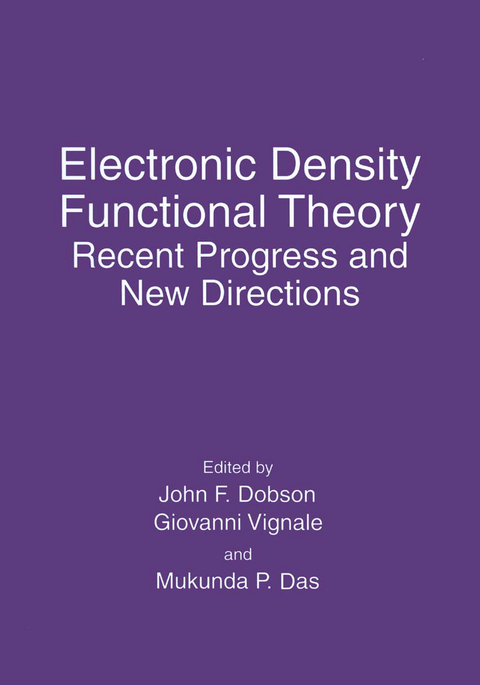
Electronic Density Functional Theory
Kluwer Academic/Plenum Publishers (Verlag)
978-0-306-45834-7 (ISBN)
This book is an outcome of the International Workshop on Electronic Density Functional Theory, held at Griffith University in Brisbane, Australia, in July 1996. Density functional theory, standing as it does at the boundary between the disciplines of physics, chemistry, and materials science, is a great mixer. Invited experts from North America, Europe, and Australia mingled with students from several disciplines, rapidly taking up the informal style for which Australia is famous. A list of participants is given at the end of the book. Density functional theory (DFT) is a subtle approach to the very difficult problem of predicting the behavior of many interacting particles. A major application is the study of many-electron systems. This was the workshop theme, embracing inter alia computational chemistry and condensed matter physics. DFT circumvents the more conceptually straightforward (but more computationally intensive) approach in which one solves the many-body Schrodinger equation. It relies instead on rather delicate considerations involving the electron number density. For many years the pioneering work of Kohn and Sham (the Local Density Ap proximation of 1965 and immediate extensions) represented the state of the art in DFT. This approach was widely used for its appealing simplicity and computability, but gave rather modest accuracy. In the last few years there has been a renaissance of interest, quite largely due to the remarkable success of the new generation of gradient functionals whose initiators include invitees to the workshop (Perdew, Parr, Yang).
I. Introductory Material.- Brief Introduction to Density Functional Theory.- Digging into the Exchange-Correlation Energy: The Exchange-Correlation Hole.- Driving out the Self-Interaction Error.- Time-Dependent Density Functional Theory.- II. Invited Chapters on Groundstate Energy Functionals.- Mixing Exact Exchange with GGA: When to Say When.- Adiabatic Coupling in the Helium and the Beryllium Series.- Derivation of a Generalized Gradient Approximation: The PW91 Density Functional.- Correlation Energy in a High-Density Limit from Adiabatic Connection Perturbation Theory.- Calculating Electronic Energies from Kohn-Sham Effective Potentials.- A Correlation-Energy Functional for Addition to the Hartree-Fock Energy.- Relativistic Corrections to the Exchange-Correlation Energy Functional.- III. Invited Chapters on Excited States, Time-Dependent DFT and the Van der Waals Interaction.- Are Unoccupied Kohn-Sham Eigenvalues Related to Excitation Energies?.- Time-Dependent Optimized Effective Potential in the Linear Response Regime.- Current-Density Functional Theory of Linear Response to Time-Dependent Electromagnetic Fields.- Effective Action in Density Functional Theory and the Berry Phase.- Hydrodynamics in the Thomas-Fermi-Dirac-von-Weizsäcker Approximation.- Van der Waals Interactions in Density Functional Theory.- Van der Waals Functionals via Local Approximations for Susceptibilities.- Bound-Free Correlation Potentials for Scattering Theory.- IV. Invited Chapters on Special Systems.- Edge Electronic Structure: The Airy Gas.- Density Functionals for Energies and Eigenvalues: Local Mass Approximation.- Ensemble Density Functional Theory for Inhomogeneous Fractional Quantum Hall Systems.- Applications of Self-Interaction Corrections to Localized States in Solids.- DensityFunctional Calculations for Molecules and Clusters — Lin, LinO, Cn.- A Functional Theory of Interacting Local Spins, Spin Polarized Electrons, and Ions: Half Metallic Magnets.- Density Functional Theory of Super-Phenomena in Condensed Systems.- V. Abstracts of Poster Presentations.- Ab Initio Calculations of Magnetic Interactions in Magnetic Metal Alloys via the LSDF Approach.- UNICHEM and Electron Momentum Spectroscopy Investigations into the Valence Electronic Structure of trans 1,3 Butadiene.- Van der Waals Interactions in Density Functional Theory.- Quantitative Electron Momentum Spectroscopy of Solids.- Participants.
| Zusatzinfo | X, 396 p. |
|---|---|
| Verlagsort | New York |
| Sprache | englisch |
| Maße | 178 x 254 mm |
| Themenwelt | Naturwissenschaften ► Chemie ► Physikalische Chemie |
| Naturwissenschaften ► Physik / Astronomie ► Atom- / Kern- / Molekularphysik | |
| Naturwissenschaften ► Physik / Astronomie ► Festkörperphysik | |
| Naturwissenschaften ► Physik / Astronomie ► Thermodynamik | |
| ISBN-10 | 0-306-45834-9 / 0306458349 |
| ISBN-13 | 978-0-306-45834-7 / 9780306458347 |
| Zustand | Neuware |
| Haben Sie eine Frage zum Produkt? |
aus dem Bereich


